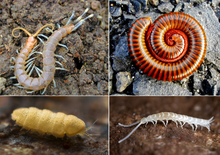
Back كثيرات الأرجل Arabic كثيرات الارجل ARZ Myriapoda AST Çoxayaqlılar Azerbaijani Күбаяҡ Bashkir Šimtkuojis BAT-SMG Мнаганожкі Byelorussian Мнаганожкі BE-X-OLD Многоножки Bulgarian Miriàpodes Catalan
| Myriapods Temporal range:
| |
|---|---|

| |
| Representatives of the four extant myriapod classes. Clockwise from top left: Chilopoda, Diplopoda, Symphyla, and Pauropoda. | |
| Scientific classification | |
| Domain: | Eukaryota |
| Kingdom: | Animalia |
| Phylum: | Arthropoda |
| Clade: | Mandibulata |
| Subphylum: | Myriapoda Latreille, 1802 |
| Classes[1] | |
Myriapods (from Ancient Greek μυρίος (muríos) 'countless', and πούς (poús) 'foot') are the members of subphylum Myriapoda, containing arthropods such as millipedes and centipedes. The group contains about 13,000 species, all of them terrestrial.[2]
The fossil record of myriapods reaches back into the late Wenlock epoch of the late Silurian,[3] although molecular evidence suggests a diversification in the Cambrian Period,[4] and Cambrian fossils exist which resemble myriapods.[2] The oldest unequivocal myriapod fossil species is Pneumodesmus from the late Silurian around 428 million years ago, which is important as the earliest known evidence of an air-breathing animal.[3][5][6] Other early myriapod fossil species are Kampecaris obanensis and Archidesmus sp. from the late Silurian around 425 million years ago.[7] The phylogenetic classification of myriapods is still debated.
The scientific study of myriapods is myriapodology, and those who study myriapods are myriapodologists.[8]
- ^ "Myriapoda". Integrated Taxonomic Information System.
- ^ a b Ben Waggoner (February 21, 1996). "Introduction to the Myriapoda". University of California, Berkeley. Retrieved November 9, 2021.
- ^ a b Wellman, C.H.; Lopes, G.; McKellar, Z.; Hartley, A. (2023). "Age of the basal 'Lower Old Red Sandstone' Stonehaven Group of Scotland: The oldest reported air-breathing land animal is Silurian (late Wenlock) in age". Journal of the Geological Society. 181. The Geological Society of London. doi:10.1144/jgs2023-138. hdl:2164/22754. ISSN 0016-7649.
- ^ Markus Friedrich & Diethard Tautz (2002). "Ribosomal DNA phylogeny of the major extant arthropod classes and the evolution of myriapods". Nature. 376 (6536): 165–167. Bibcode:1995Natur.376..165F. doi:10.1038/376165a0. PMID 7603566. S2CID 4270910.
- ^ Rowland Shelley & Paul Marek (March 1, 2005). "Millipede Fossils". East Carolina University. Archived from the original on May 27, 2011.
- ^ Garwood, Russell J.; Edgecombe, Gregory D. (September 2011). "Early Terrestrial Animals, Evolution, and Uncertainty". Evolution: Education and Outreach. 4 (3): 489–501. doi:10.1007/s12052-011-0357-y.
- ^ Brookfield, M. E.; Catlos, E. J.; Suarez, S. E. (2021-10-03). "Myriapod divergence times differ between molecular clock and fossil evidence: U/Pb zircon ages of the earliest fossil millipede-bearing sediments and their significance". Historical Biology. 33 (10): 2014–2018. Bibcode:2021HBio...33.2014B. doi:10.1080/08912963.2020.1762593. ISSN 0891-2963. S2CID 238220137.
- ^ Sue Hubbell (2000). Waiting for Aphrodite: Journeys Into the Time Before Bones. Houghton Mifflin Harcourt. p. 53. ISBN 978-0-618-05684-2.
© MMXXIII Rich X Search. We shall prevail. All rights reserved. Rich X Search